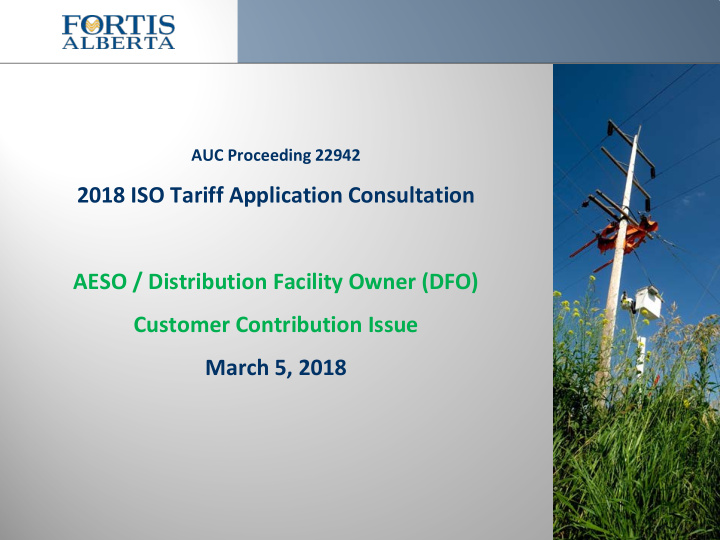



AUC Proceeding 22942 2018 ISO Tariff Application Consultation AESO / Distribution Facility Owner (DFO) Customer Contribution Issue March 5, 2018
Views from a DFO perspective • Rider I is not a new issue; debate has extended over last decade • ISO tariff must be applied in an open access, non-discriminatory manner • Any reconsideration of Rider I needs to be evaluated within: – Broader ISO tariff contribution policy and industry tariff framework • All about retaining efficient Price Signals to DFOs / End-Use Customers as they connect – Balance between pay now (contributions) or pay later (rates over time) – DFO value comes from acting as “conduit” for those transmission signals • No ISO tariff application amendment or delay required within this AESO tariff proceeding process • Recommend AESO pursue other avenues to reduce the magnitude of the AESO contribution price signal using principle-based approach
History of Rider I • Rider I - Amortization of AESO customer contributions; equates to 100% investment level for transmission facility owners (TFOs) / AESO • Concept first introduced in a 2007 AML consultation on AESO tariff contribution policy, followed by: – 2009/2010 TFO General Tariff Applications, 2009 and 2011 Generic Cost of Capital Proceedings, AESO 2010 ISO Tariff Application, Utilities R&V of Decision 2011-474, AESO 2012 Rider I Application, AUC 2013 Utility Asset Disposition Proceeding… • Debates around management fees; default / stranded asset risk to TFOs / other customers; mandatory/voluntary or opt-out/in terms, amortization/depreciation periods, and utility asset disposition (UAD) ensued. • 2015 AESO Rider I consultation – proposed a non-discriminatory (voluntary for all) form of Rider I, pending default risk terms with TFOs… • AML 2017/2018 GTA proposal; AUC struck on motion from FortisAlberta.
DFO Obligations per the EUA (s. 105) • Operate and maintain distribution (D) system Distribution Wires • Construct new and upgrade existing D facilities • Connect load and generating customers Syste tem A Acce ccess S Servi vice • Arrange access to transmission for customers (SAS AS) • Financial settlement with AESO for SAS • Responsible for reading meters and sending Meter Reading, Load consumption transactions to retailers. Settlement and • Determines the hourly energy usage from the power Distribution Tariff pool for each site for each retailer Billing • Bill Retailers for their customers’ T and D charges (Distribution Tariff)
Broader Tariff / Contribution Policy Framework • Rider I proposal neglects consideration of, or context for, the broader tariff and contribution policy framework, in terms of how the AESO / DFO tariffs and policies should operate concurrently, and how AESO contribution price signals flow-through to end-use customers through the respective tariffs: DFO Customers DFOs AESO TFOs • Small residential, farm, commercial, Distribution AESO Tariff and Transmission O&G AESO Distribution TFO Tariff and Contribution Costs (net of tariff tariff tariff • Contribution Large D Rate 63 Policy CIAC) Policy • Large T Rate 65 • AESO DG Other AESO Market tariff Participants • Direct Connect If AES O tariff is s.101(2) Customers applied in a • ISDs discriminatory • T-connected Potential for tariff shopping or preferential Generators manner
Non-Discriminatory ISO Tariff/Contribution Policy to DFOs • Balance is required between paying now (contributions, leading price signal) and paying later (rates, lagging price signal) • DFO’s are in the closest proximity, to understanding the needs of its end-use customers. • Value of DFO comes from acting as “conduit” for the AESO tariff price signals: Contracting for AESO SAS, optimized based on the transmission load/capacity requirements of the distribution system and its customers. • If DFOs are singled out for mandatory Rider I treatment, effectively results in: - 100% TFO investment in all new DFO initiated projects - removes all leading price signals to DFOs/end-use customers. • In the absence of a leading contribution price signal, potential for inefficiencies in system development; opens the door for larger market participants to: - request transmission facilities beyond their need, or - engage in “tariff shopping” between the AESO and distribution tariffs
Other Avenues to reduce the Magnitude of AESO Contributions • Review the principle-based approach and stakeholder consensus achieved in Proceeding 1162: 2012 AESO Construction Contribution Policy Proceeding, as a means of reducing the severity of the contribution price signal sent to all market participants (including DFOs). • Decision 2012-362: “…the Commission remains of the view that, at the end of the day, providing an efficient price signal is considered a more important policy objective…”; others being intergenerational equity, cost causation. • Industry should address the root cause of AML’s issue: i.e. underlying trend of rising contribution levels /insufficient transmission investment levels. • DFOs can further investigate flowing through AESO contributions to large D- connected customers, to retain leading price signals to large connecting customers.
• Comments/Questions
Recommend
More recommend